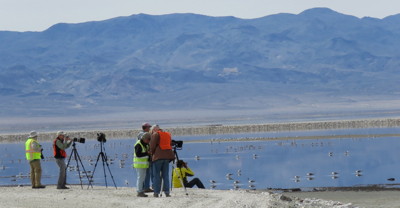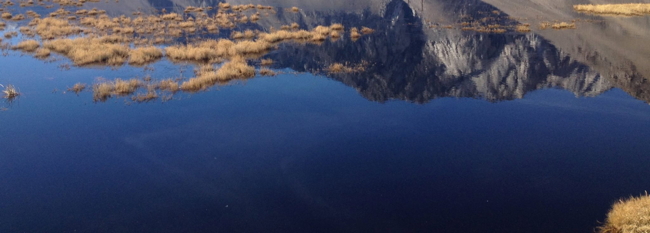
Birders at Owens Lake Big Day, April 25, 2012
Photo by Michael Prather
2015 Owens Lake Big Day Count Reports
Owens Lake Provides Refuge for Waterbirds during Record Drought
Despite record drought, participants in the 2015 Owens Lake “Big Day” Bird Counts for both Spring and Fall documented continued high bird use within the Lake’s dust control ponds. The numbers are especially encouraging given that several ponds were temporarily off-line due to the ongoing construction of Phase 7A of the Owens Lake Dust Mitigation Project, including some ponds that are typically quite productive during the bird count periods.
The Owens Lake counts are hosted by the Eastern Sierra Audubon Society and the Los Angeles Department of Water and Power (LADWP) each year to determine how many birds visit Owens Lake and help guide LADWP staff and stakeholders in the understanding and management of bird habitat within dust control areas.
The Spring 2015 Owens Lake Big Day, held on April 22, 2015, recorded over 97,000 birds and 57 different species – numbers comparable with previous non-drought year spring counts. Some species of note found during the Spring survey include Red-breasted Merganser, a Semipalmated Sandpiper, several Franklin’s Gull, and a lone Cattle Egret.
At almost 60,000 birds, shorebirds comprised approximately 60 percent of the overall Spring total, more than have ever been recorded before during a Big Day count. Waterfowl and diving waterbirds, typically found in lower numbers in spring, totaled approximately 3,000 and 4,000 respectively.
For the Fall 2015 Count, held August 20, 2015, in the midst of one of the state’s most severe droughts on record, over 14,000 birds were seen. This is particularly impressive given that late summer is always a tough time for waterbirds in the Eastern Sierra as water resources are typically at a minimum for the year. For the Fall 2015 Count, held August 20, 2015, in the midst of one of the state’s most severe droughts on record, over 14,000 birds were seen. This is particularly impressive given that late summer is always a tough time for waterbirds in the Eastern Sierra as water resources are typically at a minimum for the year.
As a drought mitigation measure “dynamic water management” was implemented for the first time on Owens Lake. Under dynamic water management, water releases were delayed to areas identified by Great Basin Unified Air Pollution Control District (GBUAPCD) as not requiring a wetted surface to control dust until later in the year. In order to help offset potential impacts to wildlife due to drought and dynamic water management, LADWP released water to the lakebed in late summer. This was the first time in history that water was released on Owens Lake outside of dust mitigation periods specifically for the benefit of migrating birds.
The technique seems to have worked given that total bird numbers in August were higher than the last three years. Shorebirds were the most abundant and diverse group as 21 species and over 11,000 shorebirds were recorded. The most notable species found include a Red Phalarope and a Pectoral Sandpiper.
Although all bird species are recorded during the surveys, the populations of specific bird guilds, including shorebirds, waterfowl and diving waterbirds, are of particular interest to stakeholders. Data from Big Day surveys track trends in bird use of the Dust Control Project area, helping guide wildlife habitat management decisions while water conservation efforts are implemented at Owens Lake, and while dust control requirements continue to be met.
The data are also used to refine the Owens Lake Habitat Suitability Model. The Habitat suitability model will be used to guide management and monitor habitat availability during implementation of the Owens Lake Master Project, a long-term collaborative project with the goal of reducing the water usage for dust control while preserving habitat for shorebirds, waterfowl, and diving waterbirds.
Eastern Sierra Audubon Society’s Mike Prather and LADWP Watershed Resources Specialist Debbie House organized the Spring and Fall 2015 Owens Lake Big Day surveys. Participants represented a team effort and included nine LADWP staff, local volunteers, Friends of the Inyo, and staff from Great Basin Air Pollution Control District, Inyo County Water Department, California Department of Fish and Wildlife, and U.S. Fish and Wildlife Service.
Click here for the official results for both 2015 Owens Lake Big Day Bird Counts
For information on future Owens Lake Big Days, contact Mike Prather at owenslake46@gmail.com.
Results of previous Owens Lake Big Days: Owens Lake Spring Big Day Counts Compared (pdf).
NOTE: For clarity, the results for 2015 were counts just for the dust control area. Over the years, the big day counts, especially the spring counts, have had varying levels of coverage. For example in some years, spring areas around the lake have been surveys. The only way to really compare differences between years is to limit it the same areas surveyed each year, otherwise the data are not really comparable.
Back to Top
2015 Owens Lake Bird festival - a Great Success!
There were over 130 people in attendance at the first Owens Lake Bird Festival, with 10 different tour options that ranged from Birding for Beginners to Aquatic Habitats of Owens Lake. The Owens Lake Bird Festival is a unique bird festival with tours of different areas of Owens Lake and tours that focus on more than just the birds themselves, although the birds were amazing out there! It is important to get a look at what has brought the birds back to Owens Lake after so many years, and what the the birds are feeding on. Owens Lake is a unique place, and the number of birds out there really matter. They are part of the reason why the LADWP dust mitigation project has been successful.
If you are interested in having a great birding opportunity and want to learn more about Owens Lake, keep an eye out for the next Owens Lake Bird Festival.
(from the Friends of the Inyo newsletter)
2014 Owens Lake Big Days
Report: Owens Lake Fall Big Day, August 21, 2014
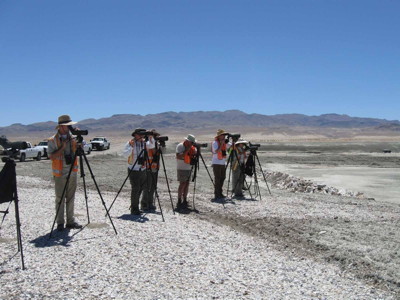
Birders on Owens Lake, Photo by Debbie House
Our Owens Lake Fall Big Day Thursday, August 21 went well. There was a good turnout of volunteers who partnered with LADWP biologists to census all birds on the lake. This is sometimes called "dip sticking" or a "snapshot" of bird populations. There are six lake-wide surveys each year and the data collected is used to manage wildlife habitat as part of the LADWP Owens Lake Master Project. Eastern Sierra Audubon helps in April and August and in fact, began the Big Days. Owens Lake is officially closed to the public due to heavy construction, so we all wore our hardhats and vests and dodged double trailer trucks hauling 20 tons of crushed rock.
Wilson's Phalaropes were common in all flooded cells. They will double their weight via fat in about two weeks and then fly non-stop to the Altiplano of Bolivia and the salt lakes of Argentina. The Wilson's were spinning furiously while feeding and also running in shallow water and along the shore chasing brine flies. In one cell there was a tight group of American Avocets and Wilson's Phalaropes in a feeding frenzy. Looking more closely we learned that they were eating brine shrimp! A few Red-necked Phalaropes were just arriving from the north as well. They will leave and spend this winter as pelagic (open ocean) birds offshore of Peru. Least Sandpipers were the most abundant "peep." There were smaller numbers of Western Sandpipers and a scattering of Baird's Sandpipers. Baird’s Sandpipers migrate in the spring north through the Midwest, but every fall many juveniles fly south through the West. We noticed their wing tips folded back beyond their tails - long wings for long flights.

Black-necked Stilts, aka "tuxedoes with sunburnt legs" over Owens Lake, photo by Ali Sheehy
Male and female American Avocets with their slender bills scythed the water searching for invertebrates. The "tuxedo with sunburned legs" Black-necked Stilts walked and picked while Long-billed Curlews probed nearby with impossibly long curved bills. Marbled Godwits, down from their pothole country breeding areas, talked among themselves. Willits flashed jet black and white underwings, Dowitchers imitated sewing machines, White-faced Ibis preened iridescent plumage and the ghostly Snowy Plovers scampered and then stopped on a dime – such ploverness. An immature Peregrine Falcon was in the area. We often see raptors hunting among the flocks of birds at Owens Lake.
See the complete list of birds seen during the Spring Count on e-bird: http://ebird.org/ebird/view/checklist?subID=S20539108
Also see LADWP Report on Fall 2014 Big Day, by Debbie House, here: http://www.ladwp.com/OwensLakeBirdCountResults
The breaking news is that Eastern Sierra Audubon is beginning the nomination of Owens Lake to be a part of the Western Hemisphere Shorebird Reserve Network (WHSRN). It appears to meet the criteria for approval due the large numbers of American Avocets, Least Sandpipers and Snowy Plovers. The three designations in WHSRN are Hemispheric, International and Regional. Owens Lake easily qualifies as an International site. The process of nomination and approval will take a few months, but should be a rewarding project in partnership with LADWP, State Lands and Audubon-California. We give a loud shout out to our members and friends who have worked (played really) on behalf of the birds at Owens Lake for so many years. It’s paying off! Visit the WHSRN website to learn more about this excellent program at www.whsrn.org.
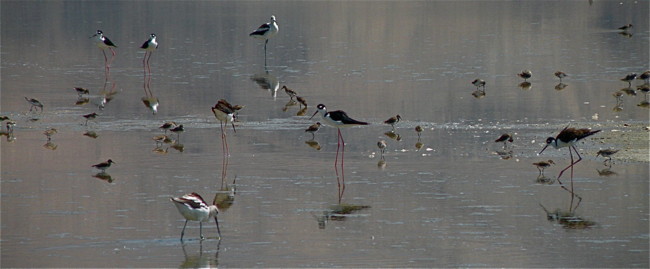
Tuxedo'd Stilts with their sunburnt legs, Avocets scything the water, and "Peeps" - lots of peeps (small sandpipers)
Photo by Mike Prather
Further shorebird reading:
Wind Birds by Peter Matthiessen
Living on the Wind by Scott Weidensaul
www.shorebirdplan.org
Michael Prather
Back to Top
2014 Owens Lake Spring “Big Day” Bird Count Records Second Highest Total Ever
Reprinted from: www.ladwp.com/ladwp/faces/wcnav_externalId/a-w-laa-owenslake-bigdayrecords
Almost 50,000 shorebirds comprised of 20 different species and an overall total of more than 75,000 birds, the second highest total number of birds ever recorded, were counted during the seventh annual Owens Lake Spring “Big Day” on April 23, 2014. Big Day bird counts have been done annually since 2008. The most birds ever recorded in the Dust Control Project area was 114,155 recorded during the Spring Big Day count in April 2013.
LADWP staff, Eastern Sierra Audubon volunteers, and other agencies recorded all bird species and individuals spotted in the entire 42-square mile Owens Lake Dust Control Project Area. Shorebirds comprised 66% of the overall total of 75,550 birds counted during the census. Waterfowl and diving waterbirds, which are typically found in lower numbers than shorebirds in spring at Owens Lake, totaled 1,520 and 3,793 respectively.
Eastern Sierra Audubon Society Education Committee Chair Mike Prather and LADWP Watershed Resources Specialist Debbie House organized the Spring 2014 Owens Lake Big Day. The 21 participants in the census included eight LADWP staff, nine volunteers, and staff from California Department of Fish and Wildlife and Inyo County Water Department.
Although all bird species are recorded during the surveys, the populations of specific waterbird guilds, including shorebirds, waterfowl and diving waterbirds, are of particular interest to stakeholders. Data from Big Day surveys tracks trends in bird use of the Dust Control Project area, helping guide wildlife habitat management decisions while water conservation efforts are implemented at Owens Lake, and while dust control requirements continue to be met.
The data is also used to refine Owens Lake habitat suitability models developed by the LADWP. Habitat suitability models will be used to monitor changes in habitat availability for waterbird guilds during implementation of the Owens Lake Master Project Concept, a long-term collaborative project with the goal of reducing the water usage for dust control while preserving habitat for shorebirds, waterfowl, and diving waterbirds.
LADWP would like to thank Mike Prather, the Eastern Sierra Audubon Society and all who participated in the census. For information regarding the use of this data, please contact LADWP Watershed Resources Supervisor Jeff Nordin at jeffrey.nordin@ladwp.com or (760) 873-0431.
The results of the census are available here: Owens Lake Spring Big Day Counts Compared (pdf).
NOTE: Over the years, the big day counts, especially the spring counts, have had varying levels of coverage. For example in some years, spring areas around the lake have been surveys. The only way to really compare differences between years is to limit it the same areas surveyed each year, otherwise the data are not really comparable.
By Debbie House, LADWP Watershed Resources Specialist, Bishop Office
Back to Top
2013 Owens Lake Spring Big Day Report
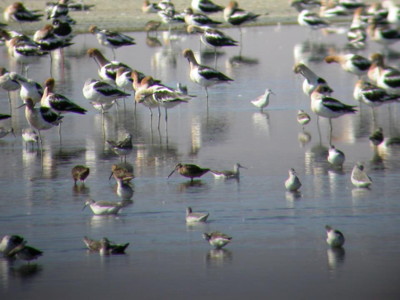
Birds on Owens Lake, Photo by Michael Prather
The Owens Lake Spring Day on April 23, 2013 results are in! It is a staggering number. Many thanks to the volunteer birders who came from all over the state and also thanks to Debbie House and her crew of LADWP biologists. We put teams out on the lake all day and are very pleased with the results.
This total of 114,999 birds on the lake in one day is a new high, the previous high being last April of ~75,000. Of significance is the shorebird total - 63,524 of 20 different species. Of course the many other species observed are also important and diverse. Results vary from year to year for many reasons so the data over time will give us the most accurate view of this amazing resource. To see the count data for the last 6 years, from 2008-2013, click here(pdf). (NOTE: Over the years, the big day counts, especially the spring counts, have had varying levels of coverage. For example in some years, spring areas around the lake have been surveys. The only way to really compare differences between years is to limit it the same areas surveyed each year, otherwise the data are not really comparable.)
Owens Lake certainly has national, if not hemispheric, importance once again as a wildlife stopover. It is Inyo County's largest wildlife location and has tremendous potential for attracting wildlife viewers in fall and spring each year. Good for all of Inyo County, but especially the southern Owens Valley.
Back to Top
2012 Owens Lake Spring Big Day Report
On April 25th twenty birders (citizen scientists) joined five LADWP staff to census all of the birds at Owens Lake. The Owens Lake Spring Big Day is an annual cooperative project conducted by Eastern Sierra Audubon and the Los Angeles Department of Water and Power. It gathers data on the number of species and individuals that use Owens Lake each spring for nesting and foraging during migration. A somewhat breezy, but mild day allowed complete coverage of the 40 square mile dust control project and the wetlands around the shoreline of the lake.
2012 was our highest number of individuals counted yet (74,511) with 81 species. Some of the birds shared by surveyors were a Sanderling, 20+ Franklin’s Gulls. Bonaparte Gulls, Peregrine Falcon, thousands of California Gulls, American Avocets and ‘peeps’ (our smaller sandpipers), dozens of Snowy Plovers and Semi-palmated Plovers and 10 American White Pelicans. You may view or download the complete list of birds from 2012 and the previous years (pdf). These numbers demonstrate the enormous return of birds to Owens Lake as a result of the Los Angeles Dust Control Project.
Areas surveyed included all Dust Control Cells, Bartlett/Carroll Creek, Sulfate Well, Cartago Wildlife Area, Cottonwood Marsh, and Dirty Socks. A total of 74,511 birds and 81 species were recorded, including over 47,000 shorebirds of 21 species. The 2012 Big Day count of shorebirds is the highest count of shorebirds recorded at Owens Lake to date since regular lake-wide surveys of the entire dust control project area were first started in 2007.
Data from the Spring Big Day is used in the management of the birds and their habitat at Owens Lake. The Draft Owens Lake Master Plan calls for the continued protection and even enhancement of wildlife habitat and wetlands. Owens Lake will once again support migrating and nesting birds and it will become an important ecotourism attraction that will help our local economy. The Owens Lake Fall Big Day is August 21st. Contact Mike Prather (owenslake46@gmail.com) to sign up.
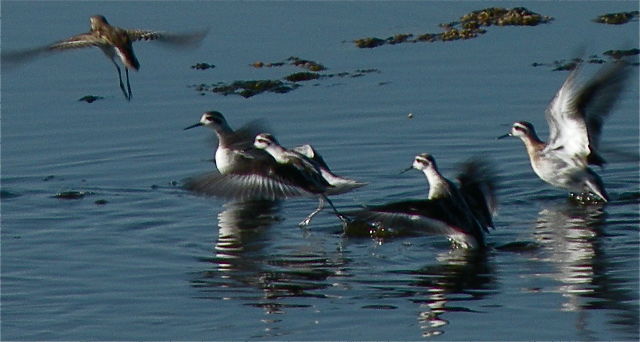
Red-necked Phalaropes at Owens Lake
Photo by Michael Prather
Back to Top
2011 Owens Lake Spring Big Day Census: 58,589 total birds
The fourth annual Owens Lake Spring Big Day was held on April 19, 2011, under perfect spring-like weather conditions. This year’s event was organized by Mike Prather, Eastern Sierra Audubon Society, and Debbie House, Los Angeles Department of Water and Power (LADWP), Watershed Resources Specialist. The twenty seven participants included birders from San Diego to Berkeley, as well as locals from Lone Pine to Mammoth Lakes, and five LADWP staff biologists.
The entire 40 square miles of the Owens Lake Dust Control Project and several shoreline spring sites were surveyed. A total of 58,589 birds and 73 species were recorded. Highlights of the count include 18,978 Calidris sandpipers including Least Sandpiper, Western Sandpiper and Dunlin, 8,200 American Avocet, 153 Greater Yellowlegs, 95 Black bellied Plover, and 58 Willet. Of the over 4,900 waterfowl recorded, Gadwall and Ruddy Duck predominated, while three Blue-winged Teal and one Red breasted Merganser were among the “less frequently encountered” waterfowl species recorded for the day. It was a five gull day at Owens Lake, with California Gulls virtually everywhere (23,248 of them tallied), and five Franklin’s Gulls, a dozen Bonaparte’s Gulls, a few-dozen Ring-billed and a couple Herring Gulls thrown into the mix.
LADWP and the Eastern Sierra Audubon Society would like to thank all who participated. The information from lake-wide Big Day counts is being incorporated into LADWP’s growing database of wildlife use of the Owens Lake Dust Control Project, and will be used to help guide management decisions regarding maintaining or improving wildlife habitat, while implementing water conservation efforts and continuing to meet dust control requirements.
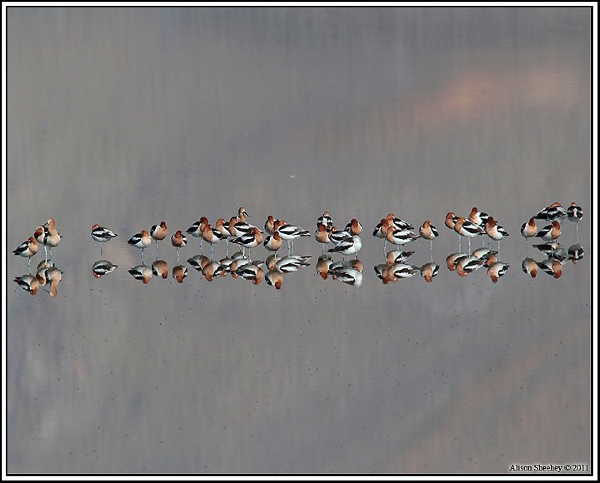
American Avocets, Owens Lake Big Day, 19 April 2011
Photo by Ali Sheehey
Past years' count data compared
Click here for a pdf of count results for the Spring Big Day at Owens Lake from 2008 through 2014. 2014 Data has been added! Also available as a spreadsheet on request.
NOTE: Over the years, the big day counts, especially the spring counts, have had varying levels of coverage. For example in some years, spring areas around the lake have been surveys. The only way to really compare differences between years is to limit it the same areas surveyed each year, otherwise the data are not really comparable.
Coordinator: Mike Prather 760-876-5807
owenslake46@gmail.com, Drawer
D Lone Pine,CA 93545
Back to Top

